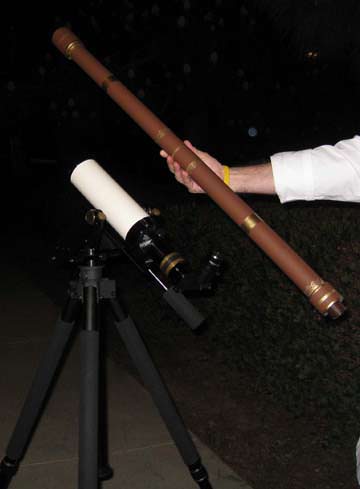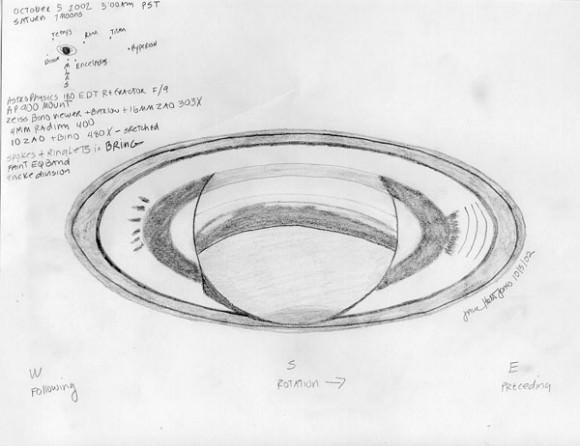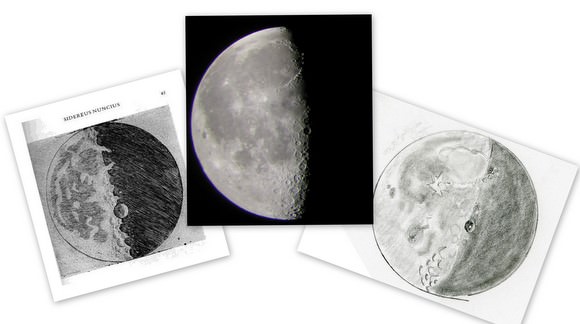[/caption]
A collage of 21-day old Moons, sketched by Galileo, (left), an image from Jane Houston Jones’ telescope, center, and Jane’s sketch, right.
Amateur astronomers have different ways of documenting their observing sessions, such as taking astrophotos or keeping a logbook. Others, like Jane Houston Jones, employ an age-old method used by Galileo Galilei himself: they take pen in hand and sketch what they see through the lens of their telescope. During this International Year of Astronomy, Jones – an amateur astronomer who also happens to work at the Jet Propulsion Laboratory — wanted to do something special to honor the legacy of Galileo, and decided to follow through with something she has been considering for quite a while. Jones is recreating all of Galileo’s astronomical sketches as she looks through a telescope similar in size to the one used by the father of modern observational astronomy. “Every time I look through a small telescope at these same objects that Galileo did, it just gives me chills,” Jones said. “It fills me with wonder every time I think that I’m seeing the same view Galileo saw 400 years ago, and I wonder what was going through his mind as he made his observations.”
Sketching isn’t new for Jones, a Senior Outreach Specialist for the Cassini mission to Saturn. “When I made my very first telescope in 1989, the first thing I did was draw pictures of what I observed,” she said, “and I’ve just continued it. It makes a wonderful journal or diary of everything you do with a telescope.”

Galileo’s first telescope had an objective diameter of 37 mm, a focal length of 980 mm, and the instrument’s magnification was 21.
Jones is using a small refractor, a Televue Ranger, which has an objective diameter of 70mm, a focal length of 480mm, and using a 25mm Zeiss Abbe Orthoscopic eyepiece, yields a comparable magnification of 19.
“My field of view is bigger than what Galileo had, but I have little less magnification, so in the end I’m getting about the same view that Galileo did. But 400 years later, with better optics, mine is easier to see,” she said. “For effect, I’m also using just a manual mount where I have to move the telescope myself up and down and side to side.”
But using a small telescope to make sketches is a challenging task, Jones is finding, and she has gained new appreciation for Galileo’s original astronomical drawings. “I’ve never observed and sketched through a small telescope before, so it’s a challenge,” she said. “I’ve always loved sketching the Moon, but I’ve usually used a much larger telescope and sketched one crater or a small feature on the terminator. I’ve never tried to sketch the whole Moon at once before, but I wanted to make the same sketches as Galileo. With his telescope, Galileo could only see a tiny portion of the Moon, maybe about 1/8 of the surface at once. And when he looked at a star cluster he couldn’t see, for example, all of the Pleiades in one view. So, I now wonder what kind of worksheet he prepared to try and connect the different views together into the larger view, because he certainly had to sweep through several views to make one sketch.”

Jones said her most memorable views during this Galilean exercise are some of the most basic things Galileo saw. “To me, the very coolest things I saw are the Galilean moons. Everybody who looks at Jupiter through a telescope sees the three or four little dots as the moons are orbiting around the planet. We take that for granted, seeing the moons lined up along the equator of Jupiter. But when Galileo looked at them, it was just amazing that he saw their movement and made the discovery.”
One of her most significant views included an object that Galileo didn’t realize was another, yet undiscovered planet. “Galileo also did a sketch showing the Galilean moons and one additional fixed star, which using modern astronomy software, we can go back to the same day of his observations, and now we know that fixed star was Neptune. To me, that was just so amazing to see all in one eyeview Jupiter, the four moons and another planet that at Galileo’s time, hadn’t been discovered yet, and wouldn’t be discovered for several hundred years.”

Now, she is working sketching Saturn, which is interesting given Saturn just went through equinox, meaning the rings have “disappeared” from our vantage point on Earth. “When Galileo first looked at Saturn, he thought he saw three objects – the planet and the rings on both sides of Saturn, And of course he looked at Saturn again a few years later and the rings had disappeared. I’m working on getting my sketches of Saturn over the years to try and match up what Galileo sketched.”
After Saturn, Venus is her next target for sketching.
Since Jones has been sketching for 20 years, she said she won’t quit after the IYA. “To me it makes a diary that follows a tradition that goes back centuries. I like to do that, because I can then take my sketches and look at Galileo’s or other centuries-old views of the same objects and I have a connection with those observers because we held a pen or pencil in our hand while looking through an eyepiece and made notes of what we see. I like that. Plus it’s such a fun project and I’m learning so much about Galileo’s observations, as well as some of the current scholars who are documenting his observations and researching his sketches. It’s a great learning experience, besides the artistic and personal satisfaction of drawing something. It’s a great history lesson.”
Jones and her husband Morris are members of the Old Town Astronomy group, which does “Urban Guerrilla Astronomy,” where they set up their telescopes on city sidewalks providing the public a chance to look through telescopes. Click here for a video about what they do.
In her day job at JPL, Jones does educational outreach for the Cassini mission, working with the public, museums, planetariums, astronomy clubs, and an international network of volunteers called the Saturn Observation Campaign. Additionally she is the Twitter voice of Cassini. But she also creates a monthly podcast for JPL called “What’s Up” about what is visible in the night sky each month. “It’s really neat to have astronomy part of my day job as well as my passion in life,” she said.
For more of Jones’ observations and sketches, check out her website, and this specific page about observing with a small refractor.


Nice to see some “old fashioned” astronomy being practiced….way to go Jane! I look forward to future astronomical drawings. BTW, any way for me to get involved in the Old Town Astronomy group?
Clear Skys!!
I guess I should have gone to the Old Town Astronomy group site prior to asking the question. Seems I need to practice “guerilla astronomy” up here in No. Cal.